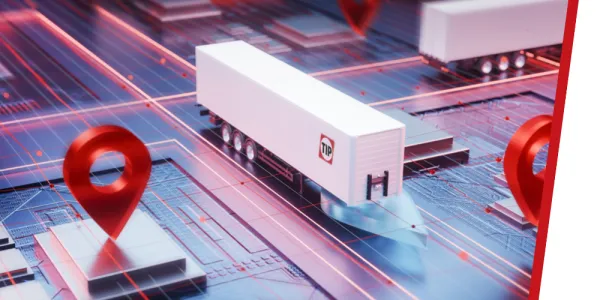The future of tyre safety: how Tyre Pressure Monitoring System (TPMS) is evolving
TPMS (Tyre Pressure Monitoring System) is a technological solution that helps drivers in monitoring tyres’ air pressure. The system consists of sensors installed inside each tyre and transmit data to a dashboard display or a warning light in the vehicle. The purpose of TPMS is to warn drivers when tyre pressure is too low, which can lead to unsafe driving conditions and decreased fuel efficiency. Regulations mandating the installation of TPMS in vehicles is imminent, which sparks attention among stakeholders and makes it a hot topic in the transportation industry. Therefore, in this article, we aim to provide a quick guide to TPMS and its present challenges.
The need for TPMS: Overcoming the dangers of low tyre pressure
TPMS was developed in response to the growing concern over tyre safety and the dangers of low tyre pressure. Prior to TPMS, drivers had to rely on manual checks, which were frequently overlooked or forgotten. This led to a high number of vehicles being driven with underinflated tyres, consequently having an impact on road safety, but also on gas mileage efficiency.
Low tyre pressure can result in:
-
Tyre failure
-
Reduced road grip and increased risk of accidents
-
Decrease fuel efficiency
-
Longer stopping distances
-
Increased wear and tear on tyres
-
Premature replacement of tyres
-
Increased maintenance
-
Increased costs
The European Union has consistently shown its commitment to improving road safety, and the mandatory fitment of TPMS on vehicles is a testament to that.

TPMS: the basics
There are two types of TPMS systems: Direct TPMS and Indirect TPMS. Direct TPMS uses pressure sensors in each tyre, while Indirect TPMS uses ABS wheel speed sensors to detect changes in tyre pressure. TPMS provides several benefits such as improving fuel utilization, extending tyre life, and enhancing vehicle safety. However, it's not a substitute for regular tyre maintenance and manual tyre pressure checks. Regular recalibration and battery replacement may be necessary.
For more info about the TPMS features, please have a look at our previous article.
UNECE R141: TPMS regulation for vehicles
According to the UNECE R141 regulation, a vehicle integrating TPMS is only approved if it satisfies the following requirements:
-
The system's effectiveness should not be affected by magnetic or electric fields.
-
The system should operate from or below the speed of 30km/h up to the vehicle’s maximum design speed.
-
The vehicle should fulfil the tests such as puncture, diffusion, and malfunction.
Conformity of production is also clearly defined in this regulation, and the approval authority, such as KBA, can verify it at any time, usually once a year. In case of non-conformity, the approval for that specific vehicle type may be revoked.
Vehicles in the EU are categorized into three classes: M stands for the vehicles for passengers (e.g., cars), N stands for the vehicles for carriage of goods (e.g., trucks), and O stands for the trailers for carriage of the goods. In 2014, TPMS became a requirement for all new M1 vehicles, and was later extended to N1 vehicles, in 2017. With the proven effectiveness of TPMS, the EU continues to advance its legislation and enhance road safety. The latest update, introduced in 2019, calls for the mandatory installation of TPMS on a wider range of vehicles, including M2, M3, N2, N3, O3, and O4. This effort is poised to lead the way towards safer and more efficient roadways in the EU.

Overcoming interoperability challenges in TPMS for trucks and trailers: the road ahead
Interoperability is currently a key challenge in the development of TPMS for trucks and trailers. Lack of standardization among different sensors leads to compatibility issues, which can result in increased costs and safety risks for drivers. To address these challenges, solutions such as creating a universal, standardized system for all TPMS systems or developing a wireless communication protocol that allows all sensors to communicate with each other, regardless of the type of sensor being used, are being proposed.
Collaboration among players in the industry is key to implementing these solutions and ensuring greater safety, efficiency, and cost savings for drivers. It is important to note that while TPMS technology is still developing, standardization efforts are underway to overcome the interoperability challenge, and drivers can expect to see improvements in the future.
Never letting your guard down with TIP’s TyrePlus TMPS tyre sensor
Here at TIP, we understand how important it is to maintain a correct tyre pressure and avoid incidents and major costs for fleet operators. That is why we offer TyrePlus, our own solutions that detect slow punctures early and save costs by reducing vehicle downtime and fuel consumption. By transmitting tyre data and alerts via a modem to the fleet management system, the sole dependency on the truck driver’s action is reduced, allowing fleet manager to promptly respond and maximize the potential benefits.
TyrePlus is a next-gen tyre pressure monitoring solution for trailers designed to reduce fleet costs and improve vehicle safety. TyrePlus detects under/over-inflated tyres, provides temperature data for early leakage detection, reduces fuel costs, breakdowns, CO2 emissions, tyre theft and helps ensure trailers run on schedule.
TyrePlus works with all types of trailers and continuously provides updates on tyre pressure and temperature through internally mounted sensors. It delivers data to fleet depots for maintenance scheduling as required.
Interested to know more? Click here and get in touch!









